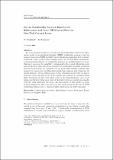Files in this item
On the relationship between equilibrium bifurcations and ideal MHD instabilities for line-tied coronal loops
Item metadata
| dc.contributor.author | Neukirch, T. | |
| dc.contributor.author | Romeou, Z. | |
| dc.date.accessioned | 2012-02-06T10:31:03Z | |
| dc.date.available | 2012-02-06T10:31:03Z | |
| dc.date.issued | 2010-01 | |
| dc.identifier.citation | Neukirch , T & Romeou , Z 2010 , ' On the relationship between equilibrium bifurcations and ideal MHD instabilities for line-tied coronal loops ' , Solar Physics , vol. 261 , no. 1 , pp. 87-106 . https://doi.org/10.1007/s11207-009-9480-0 | en |
| dc.identifier.issn | 0038-0938 | |
| dc.identifier.other | PURE: 2227738 | |
| dc.identifier.other | PURE UUID: 798619f6-bd9e-4e4d-b454-53f85ca76a2d | |
| dc.identifier.other | WOS: 000272912600006 | |
| dc.identifier.other | Scopus: 76349103951 | |
| dc.identifier.other | ORCID: /0000-0002-7597-4980/work/34032294 | |
| dc.identifier.uri | https://hdl.handle.net/10023/2268 | |
| dc.description.abstract | For axisymmetric models for coronal loops the relationship between the bifurcation points of magnetohydrodynamic (MHD) equilibrium sequences and the points of linear ideal MHD instability is investigated, imposing line-tied boundary conditions. Using a well-studied example based on the Gold -aEuro parts per thousand Hoyle equilibrium, it is demonstrated that if the equilibrium sequence is calculated using the Grad -aEuro parts per thousand Shafranov equation, the instability corresponds to the second bifurcation point and not the first bifurcation point, because the equilibrium boundary conditions allow for modes which are excluded from the linear ideal stability analysis. This is shown by calculating the bifurcating equilibrium branches and comparing the spatial structure of the solutions close to the bifurcation point with the spatial structure of the unstable mode. If the equilibrium sequence is calculated using Euler potentials, the first bifurcation point of the Grad -aEuro parts per thousand Shafranov case is not found, and the first bifurcation point of the Euler potential description coincides with the ideal instability threshold. An explanation of this results in terms of linear bifurcation theory is given and the implications for the use of MHD equilibrium bifurcations to explain eruptive phenomena is briefly discussed. | |
| dc.format.extent | 20 | |
| dc.language.iso | eng | |
| dc.relation.ispartof | Solar Physics | en |
| dc.rights | This is an author version of an article published in Solar Physics, (c) Springer Science+Business Media B.V 2009. The original publication is available at www.springerlink.com | en |
| dc.subject | Corona, structures | en |
| dc.subject | Flares, relation to magnetic field | en |
| dc.subject | Instabilities | en |
| dc.subject | Magnetohydrodynamics | en |
| dc.subject | Free cylindrical equilibria | en |
| dc.subject | Solar eruptive processes | en |
| dc.subject | Kink instability | en |
| dc.subject | Numerical simulations | en |
| dc.subject | Stability analysis | en |
| dc.subject | Onset conditions | en |
| dc.subject | Magnetic-fields | en |
| dc.subject | Current layers | en |
| dc.subject | Current sheets | en |
| dc.subject | Evolution | en |
| dc.subject | QB Astronomy | en |
| dc.subject.lcc | QB | en |
| dc.title | On the relationship between equilibrium bifurcations and ideal MHD instabilities for line-tied coronal loops | en |
| dc.type | Journal article | en |
| dc.contributor.sponsor | PPARC - Now STFC | en |
| dc.contributor.sponsor | European Commission | en |
| dc.description.version | Postprint | en |
| dc.contributor.institution | University of St Andrews. Applied Mathematics | en |
| dc.identifier.doi | https://doi.org/10.1007/s11207-009-9480-0 | |
| dc.description.status | Peer reviewed | en |
| dc.identifier.url | http://www.scopus.com/inward/record.url?scp=76349103951&partnerID=8YFLogxK | en |
| dc.identifier.grantnumber | PP/E001122/1 | en |
| dc.identifier.grantnumber | en |
This item appears in the following Collection(s)
Items in the St Andrews Research Repository are protected by copyright, with all rights reserved, unless otherwise indicated.

